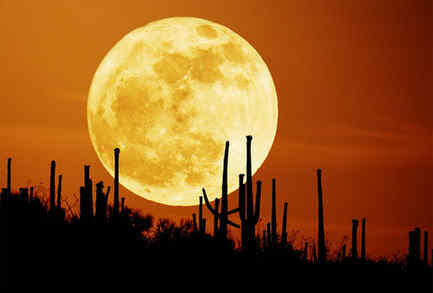上周六晚现身的“超级月亮”照亮了各国的夜空,同时也打破了其与日本地震相关的传言。据报道,周六晚间月球与地球之间的距离不到36万公里,为两者之间最近的距离,这种现象叫做“最大近地点”,每18年才会发生一次。之前网上传言,“超级月亮”现身期间,地球会出现地震、洪水以及火山爆发等自然灾害。而在日本特大地震发生后,这一说法引起了更多网友的关注。对此,美国地质学家表示,虽然地月距离引发的潮汐变化会对地质活动产生轻微的影响,但日本大地震是多种地质条件共同影响的结果,与“超级月亮”并无明显关联。另外,日本地震发生时月亮并未处于离地球最近的位置,而当时海洋潮汐也处于相对最低潮期间,因此,将日本地震归罪于“超级月亮”是不合理的。

 |
|
The rare lunar occurrence, when Earth's natural satellite is only a mere 356,575 kilometers out in orbit, brings the moon to its closest position to Earth. |
The 'maximal perigee' on Saturday night has only a minimal effect on seismic activity and cannot be linked with last week's earthquakes in Japan.
The rare lunar occurrence, when Earth's natural satellite is only a mere 356,575 kilometers out in orbit, brings the moon to its closest position to Earth.
This phenomenon of extreme proximity, known as 'maximal perigee,' only occurs once every 18 years. In addition to appearing to be uncommonly big to stargazers, the moon will also be in its full phase. However, what some might see as an interesting astronomical event raises concerns for others.
Despite opinions being dispersed over the Internet that the 'super moon' will lead to natural disasters such as earthquakes, floods and volcanic eruptions, geologist Bill Burton with the US Geological Survey says that this is unlikely.
"There are just too many factors that go into seismic activity to make that statement," Burton told Discovery News. "I think you'd be hard pressed to see a difference in tectonic activity during different lunar phases."
Severe natural disasters such as the earthquake off the coast of Japan last week can raise questions about all of the factors involved. Research geophysicist Malcom Johnston with the USGS says that blaming such events on the moon's orbit is not a new idea.
"This idea of blaming natural disasters on the phases of the moon goes way back to the Greeks. It has been around for hundreds and hundreds of years," Johnston said.
These ideas, Burton adds, are largely unfounded. He noted, however, that a higher tide does have a very slight effect on tectonic activity.
"Obviously the oceans are affected by the moon; whether it causes earthquakes is under debate," Burton said. "Some minor, very shallow quakes might take place during full tide and perigee."
He explained that an increase in water pressure caused by the lunar phases might cause very minor tremors, but only if other conditions were already aligned for an earthquake to occur. Seismologists theorize that the higher tide could cause an earthquake to occur just a few days or hours earlier than it would have at normal tide.
"This might be the little push that would cause the tectonic plates to slip," Johnston told Discovery News. "Overall, the effect is negligible. But if you take data on ten thousand earthquakes, you can show there is a significant correlation between minor quakes and where the moon is in its orbit. Looking at one quake, no."
While the phases of the moon might have a minimal effect on small movements of the tectonic plates, Burton says that the correlation with major seismic activity is near nonexistent. He also stressed that the maximal perigee had nothing to do with the events in Japan.
"The Japanese quake didn't occur while the moon was close to Earth at all, so we can't link those events. It occurred a week before the lunar perigee, while the ocean was at weak tide."
Burton predicts that the only earthly change that will occur because of the moon's increased proximity will be a slightly higher tide.
相关阅读
(Agencies)

(中国日报网英语点津 Helen 编辑)